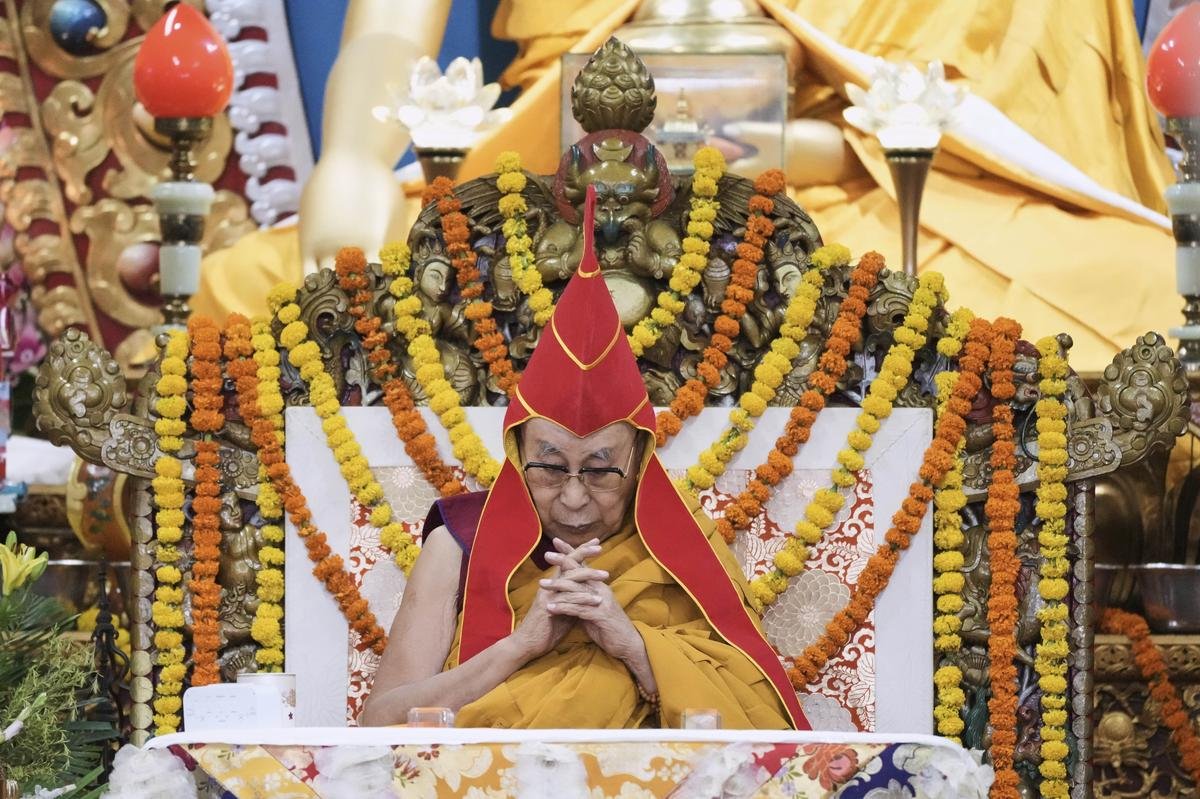The Dalai Lama is not just the spiritual head of Tibetan Buddhism—he is the living heartbeat of the Tibetan people. Believed to be the reincarnation of Avalokiteśvara, the bodhisattva of compassion, each Dalai Lama is part of a centuries-old chain of leaders embodying kindness, wisdom, and the deep resilience of Tibetan identity.
According to Reuters, Tenzin Gyatso, the current and 14th Dalai Lama, has become a global icon for peace and non-violence. But as he grows older, attention is shifting to a complex, delicate question: who will come next?
How a Dalai Lama Is Chosen
The succession of the Dalai Lama is one of the most unique spiritual processes in the world. It is not about election or appointment—it’s about reincarnation.
The search begins shortly after the death of the Dalai Lama. Senior monks from the Gelugpa tradition look for signs that may guide them to the next leader. These signs can appear in dreams, the direction of smoke from the cremation, or in visions seen in sacred lakes like Lhamo Latso.
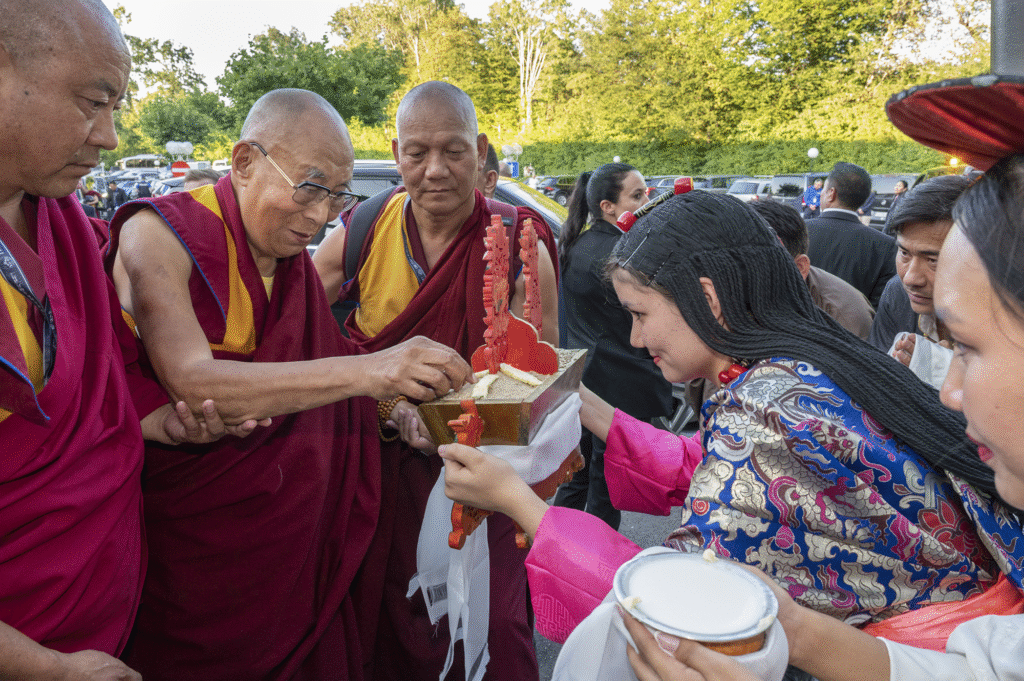
Once clues point to a possible region, a search party is formed. Monks travel far and wide to find a child born around the time of the Dalai Lama’s passing who shows special signs of being the reincarnation.
When a child is found, he undergoes recognition tests. These can include choosing personal items that belonged to the previous Dalai Lama from a collection of similar objects, recognizing people he’s never met, or showing wisdom and intuition well beyond his years.
If the child passes these sacred tests, high lamas, close disciples, and sometimes the Panchen Lama—another senior figure in Tibetan Buddhism—confirm the choice. The child is then formally recognized and prepared to step into the monumental role.
The Current Dalai Lama’s Vision for His Successor
Tenzin Gyatso has not left the future to chance. In his book Voice for the Voiceless, he made it clear that his reincarnation would likely be born outside of China. He has promised to offer more details as he approaches his 90th birthday.
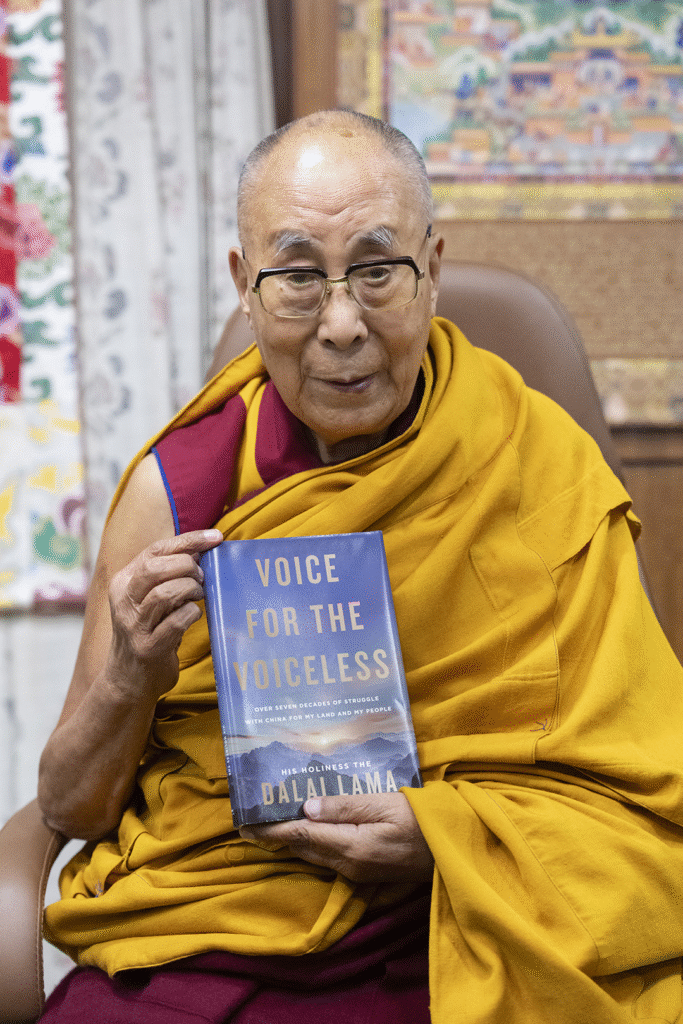
In a recent public address in Dharamshala, he briefly mentioned that a framework will eventually guide the succession process. Though he didn’t elaborate, his words hinted that the Tibetan community is already thinking beyond tradition—planning for a successor in a modern, politically charged world.
China’s Claim Over the Succession
Beijing insists that it has the final say in choosing the next Dalai Lama. China’s position is tied to a Qing dynasty ritual from 1793, where the names of possible successors are drawn from a golden urn.
Chinese officials argue that national laws require this method and that the next Dalai Lama must be born within China’s borders. But many Tibetans see this as a way for China to control their religion and undermine Tibetan independence.
The golden urn has become more than a symbol—it’s a battleground between faith and state.
India’s Crucial Role
India has been home to the Dalai Lama and the Tibetan government-in-exile since 1959, after the failed uprising against China. More than 100,000 Tibetan refugees live mainly in and around Dharamshala.
India’s involvement is not just logistical—it’s deeply political. As the host of the Tibetan community, India holds influence in the succession debate. The question is: how far will New Delhi go in supporting a successor not approved by China?
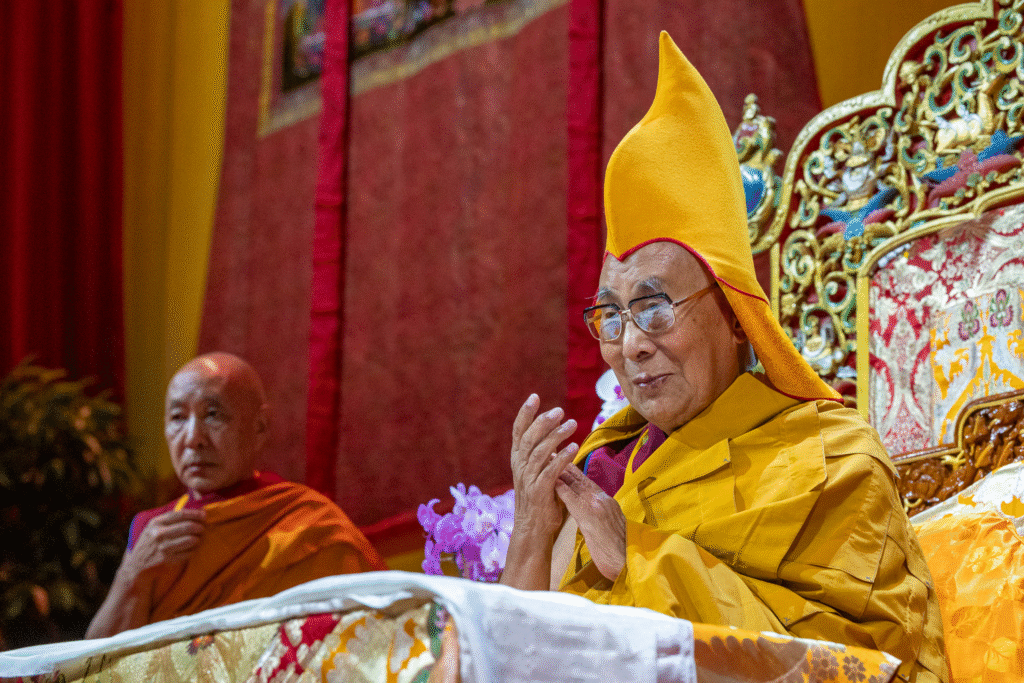
The United States Steps In
The U.S. has long supported Tibetan rights and has consistently raised concerns about China’s handling of Tibet’s autonomy. In 2024, President Joe Biden signed a law urging Beijing to address Tibet’s demands for greater freedom and self-determination.
For Washington, backing Tibet serves both humanitarian and strategic purposes. Supporting the Tibetan cause reinforces the U.S. image as a defender of religious freedom and gives it leverage in its broader rivalry with China.
The High Stakes of July 6
The birthday of the current Dalai Lama, July 6, is always significant, but as his succession looms, this year’s celebration carries added weight.
Tibetans and the global community will watch closely for any announcements, signals, or clarifications about what the future holds for Tibetan Buddhism.
A Clash of Beliefs and Borders
The succession of the Dalai Lama is no longer just a religious event. It’s now entangled in international politics, sovereignty, and the cultural survival of the Tibetan people.
China’s insistence on controlling the process clashes with Tibetan religious traditions. For many Tibetans, this is an unacceptable interference. The tension is growing, and so is worldwide interest in how this story will unfold.
The Dalai Lama’s succession could set the stage for a new chapter in global debates about freedom, faith, and power.
Timeline: The Selection Journeys of the Dalai Lamas
1st Dalai Lama: Gendun Drub (1391–1474)
- Selection: Identified as a gifted student of Tsongkhapa, founder of the Gelug school.
- Process: No formal search; recognized for extraordinary spiritual insight.
2nd Dalai Lama: Gendun Gyatso (1475–1548)
- Selection: Identified as the reincarnation of Gendun Drub.
- Process: Based on recognition by lamas; began establishing the reincarnation system.
3rd Dalai Lama: Sonam Gyatso (1543–1588)
- Selection: Identified through visions and consultations with high lamas.
- Process: First to be formally recognized with the title “Dalai Lama.”
4th Dalai Lama: Yonten Gyatso (1589–1612)
- Selection: Mongolian child, identified after significant signs.
- Process: Selection cemented Tibetan-Mongolian spiritual ties.
5th Dalai Lama: Ngawang Lobsang Gyatso (1617–1682)
- Selection: Identified through traditional reincarnation signs.
- Process: United Tibet politically; established the Potala Palace.
6th Dalai Lama: Tsangyang Gyatso (1683–1706)
- Selection: Chosen after visions and spiritual confirmations.
- Process: Known for his poetry and unconventional lifestyle.
7th Dalai Lama: Kelzang Gyatso (1708–1757)
- Selection: Identified through oracles and visions.
- Process: Reinstated by Qing imperial authorities after Tibetan conflicts.
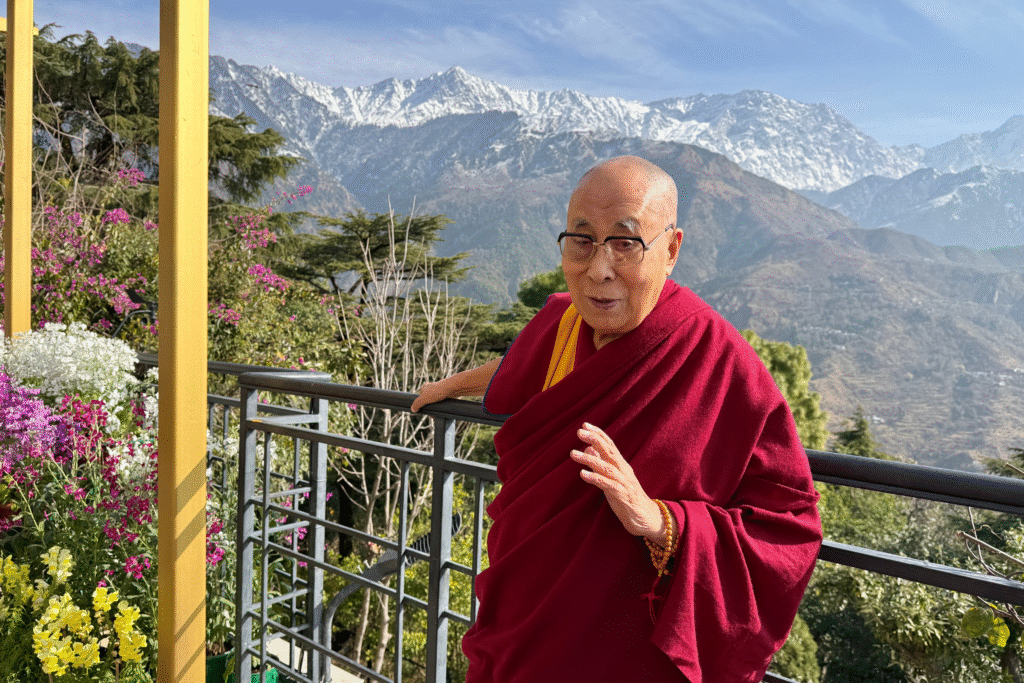
8th Dalai Lama: Jamphel Gyatso (1758–1806)
- Selection: Chosen via signs, dreams, and golden urn confirmation.
- Process: Qing dynasty reinforced golden urn tradition.
9th Dalai Lama: Lungtok Gyatso (1805–1815)
- Selection: Identified through traditional methods.
- Process: Passed away at a young age.
10th Dalai Lama: Tsultrim Gyatso (1816–1837)
- Selection: Chosen using the golden urn procedure.
- Process: Died young, leading to quick successive selections.
11th Dalai Lama: Khedrup Gyatso (1838–1855)
- Selection: Identified through religious rituals and golden urn.
- Process: His reign was overshadowed by Qing influence.
12th Dalai Lama: Trinley Gyatso (1857–1875)
- Selection: Chosen via traditional recognition and golden urn.
- Process: Died early, continuing the cycle of brief reigns.
13th Dalai Lama: Thubten Gyatso (1876–1933)
- Selection: Identified through sacred signs and tests.
- Process: Modernized Tibet, resisted foreign interference.
14th Dalai Lama: Tenzin Gyatso (1935–Present)
- Selection: Identified by a search party using dreams, omens, and sacred lake visions.
- Process: Recognized at age two; formally enthroned at age fifteen after rigorous tests.
Map of Sacred Sites in the Succession Journey
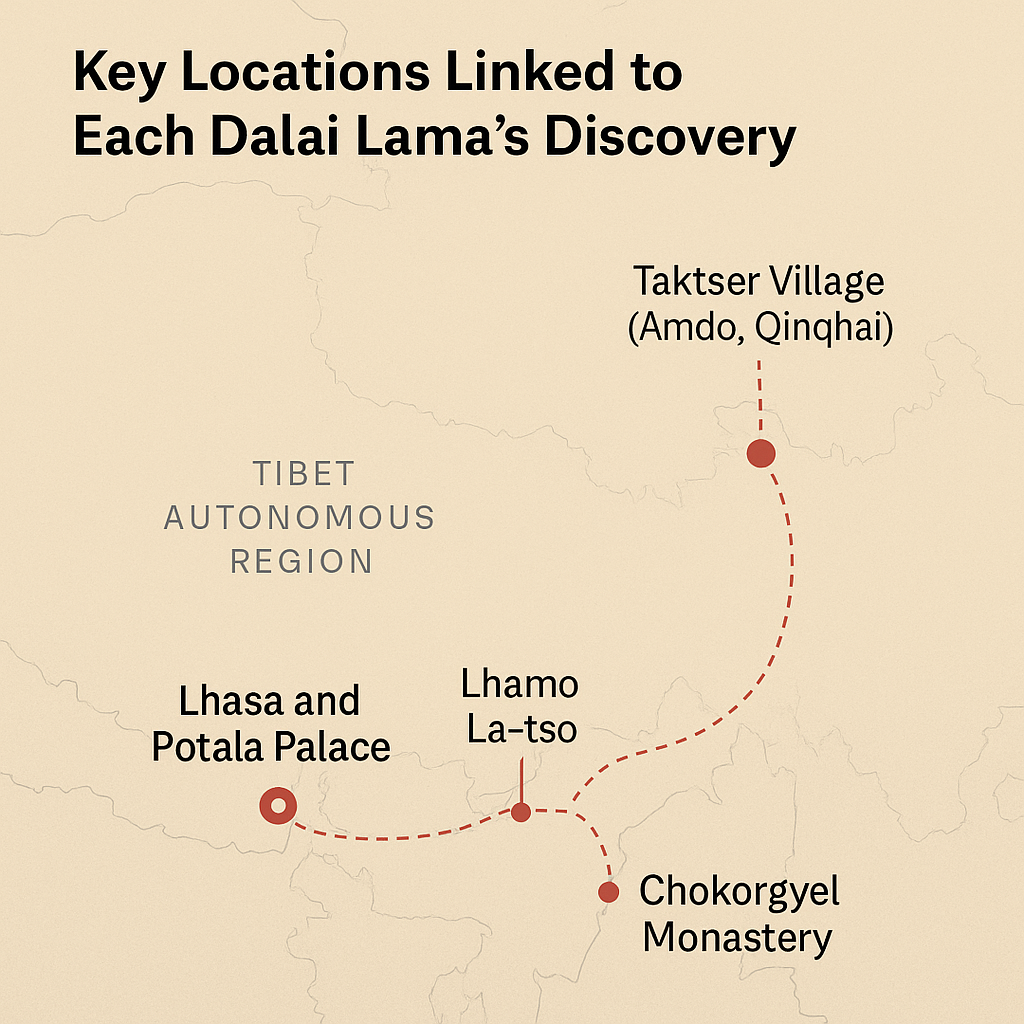
Lhamo La-tso
Location: Gyaca County, southeast of Lhasa
Significance: Known as the “Oracle Lake,” this sacred site is where Tibetan monks seek visions to help identify the reincarnation of the Dalai Lama. It has been central to the selection process for centuries.
Chokorgyel Monastery
Location: Approximately 115 kilometers northeast of Tsetang
Significance: Monks meditate and prepare here before traveling to Lhamo La-tso. This monastery, founded by the 2nd Dalai Lama, remains deeply tied to the succession rituals.
Taktser Village
Location: Amdo, Qinghai Province (historically Eastern Tibet)
Significance: Birthplace of the 14th Dalai Lama, Tenzin Gyatso. His discovery here in 1935 shaped the Tibetan exile movement and holds emotional significance for the community.
Lhasa and Potala Palace
Location: Lhasa, Tibet Autonomous Region
Significance: The traditional spiritual and political heart of Tibet. The Potala Palace is the ceremonial seat where Dalai Lamas are enthroned. It is a symbol of Tibetan identity and leadership.
Read More: How Russia’s War in Ukraine Is Costing It Old Friends?
Watch India Pakistan Breaking News on The Ink Post. Get Latest Updates, Latest News on Movies, Breaking News On India, World, Explainers.
Follow us on Facebook and Instagram and LinkedIn and Twitter to Stay updated!
